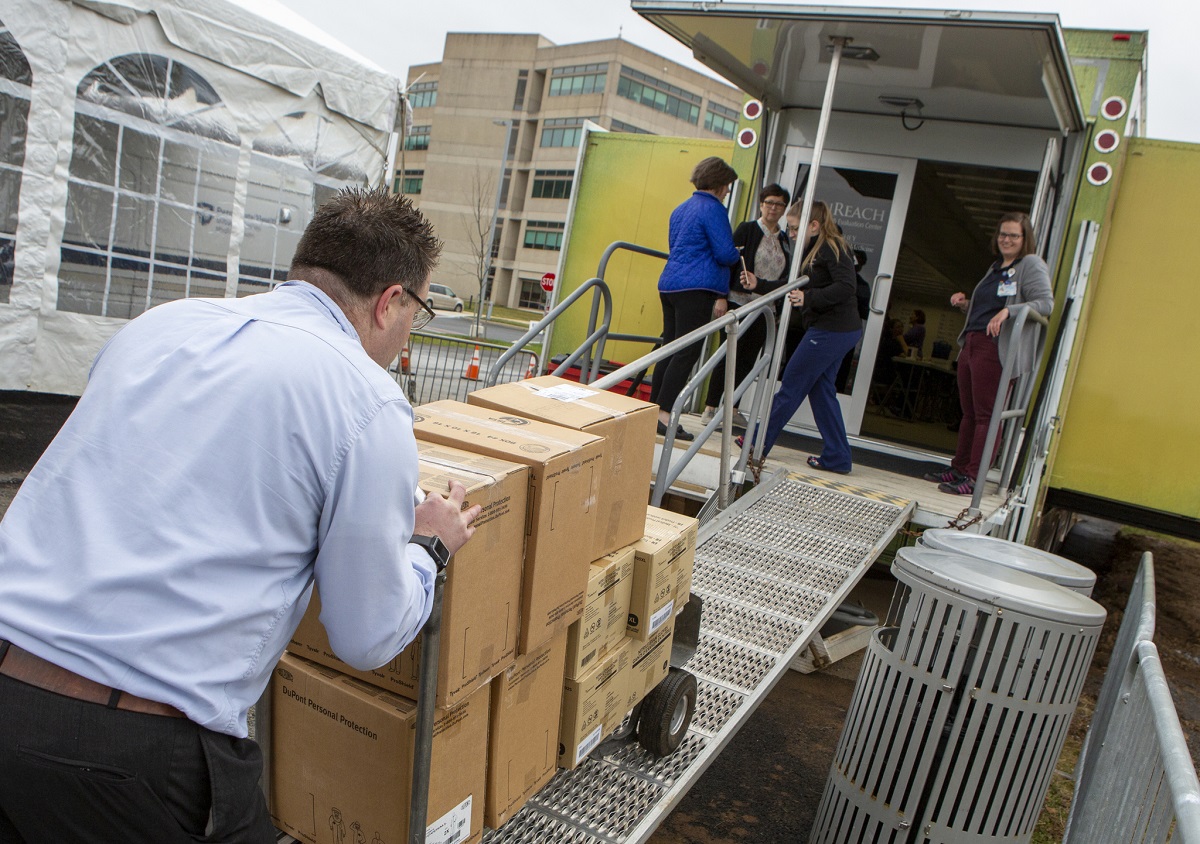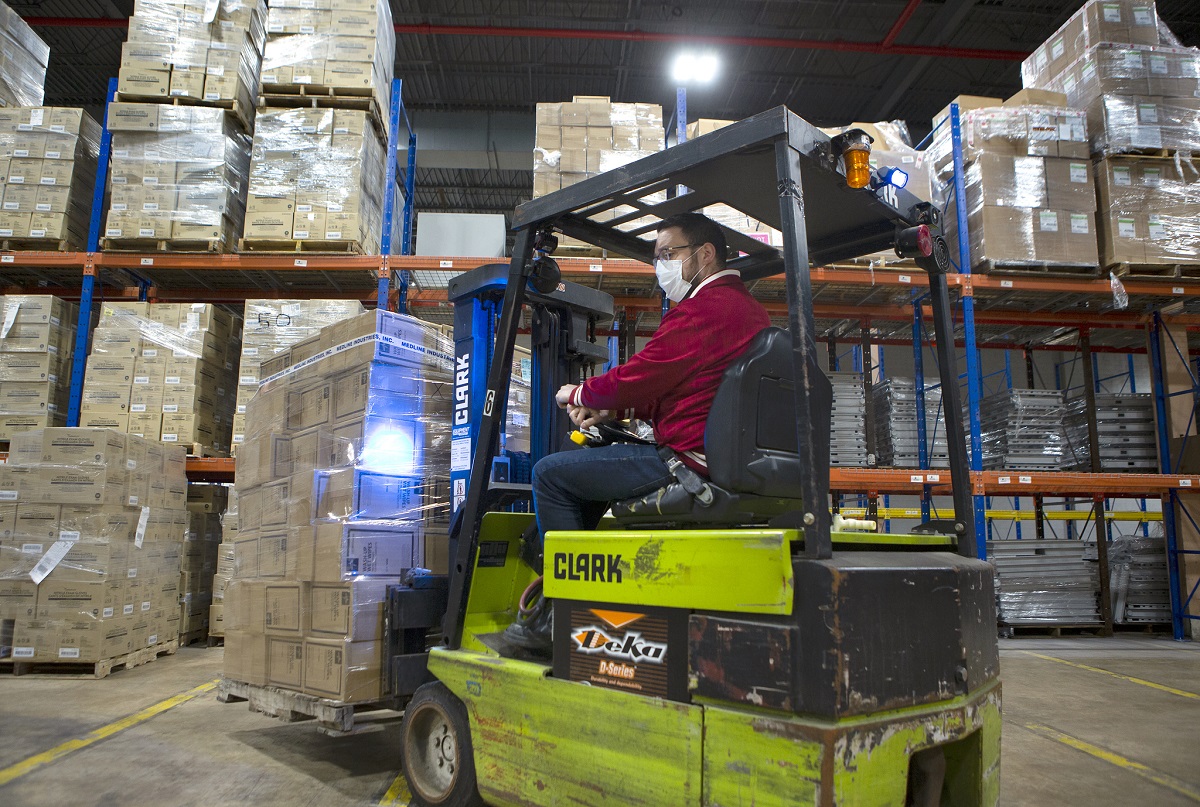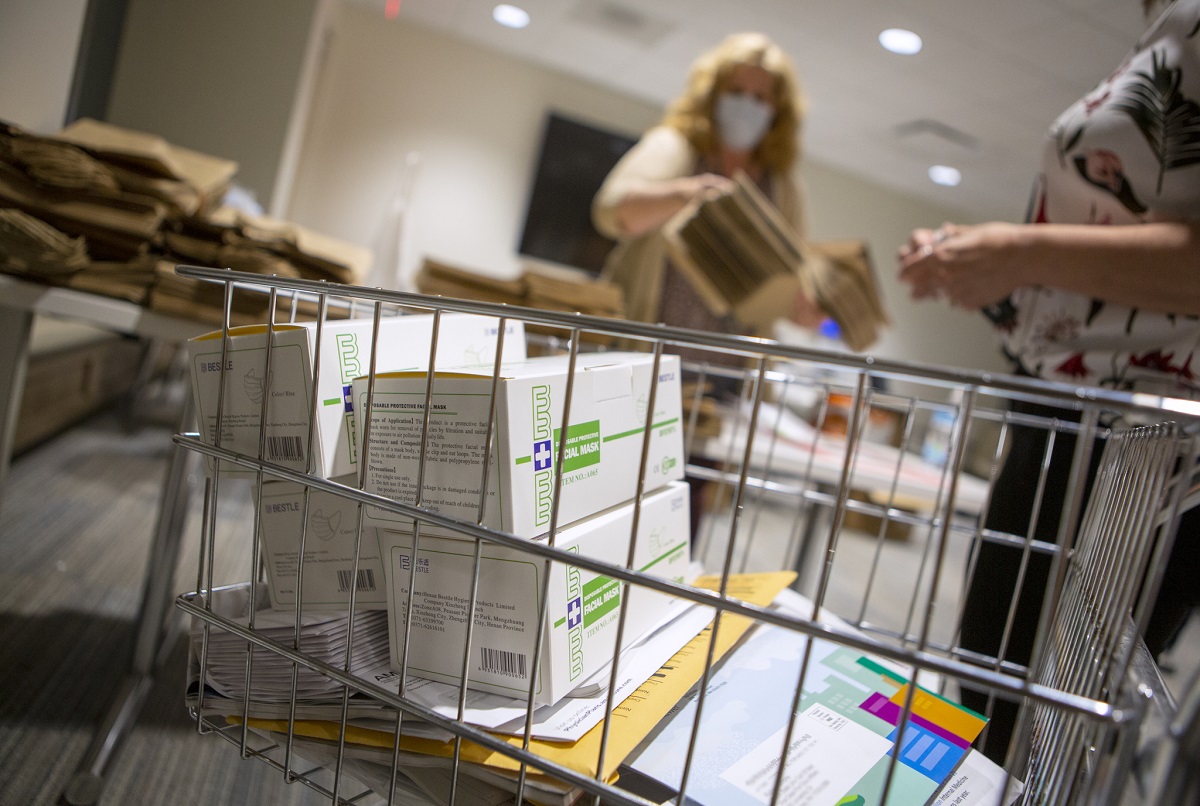Supply Chain reaction: An inside look at how the team pumped up supplies for COVID-19

By Buffy Andrews, Carolyn Kimmel, Kyle Hardner and Bill Landauer
A clinician in a COVID-19 unit reaches for an isolation gown and a mask.
In a perfect world — or at least the world health care workers and patients desperately need — the mask and gown are simply there. No one stops to ponder how they arrived. All that matters is the personal protective equipment (PPE) can protect patients and employees from the spread of a deadly virus.
But during the worst pandemic in a century, the stakes over how the gown and mask get there couldn’t be higher.
As the reality of COVID-19 crested over the nation this spring, hospital supply rooms became a focal point of fear. Would stockpiles of masks, gowns, ventilators and hand sanitizer withstand the expected lines of sick patients?
“The global supply chain has been turned on its head,” said Brian Schneider, Penn State Health director of supply operations. “You hear the news and see the challenges other hospitals and health systems are encountering. This team has walked through walls. It’s the equivalent of climbing Mount Everest, and we’re prepared to keep climbing for what the future may bring.”
“I am humbled by the selfless support of so many fellow Penn State Health, community partners and leadership support in our moment of crisis,” said Richard Bagley, Penn State Health senior vice president and chief supply chain officer. “Quick engagement and support from operations and leadership enabled us to manage our supply utilization and protect our employees and patients.”
While it got dicey from time to time, Penn State Health’s systemwide Supply Chain met the pandemic head-on, with a collective resolve that said, “Yes, we can.” They partnered to build new tracking dashboards and procured new warehouse space. They scoured the globe for suppliers when wells went dry. Office workers and health care professionals took turns working as stocking clerks. The system even rented vans to make daily deliveries of supplies.
Through it all, the men and women who make up Supply Chain — along with borrowed staff from other departments — functioned as a team, setting up play, passing the ball, scoring – in this example – masks and gowns.
It starts with that clinician reaching for protective equipment.
Simply put, Supply Chain makes sure it is there.
Step 1: Determining the need
![Hands reach for boxes marked “Disposable Protective Facial Mask” positioned in a stack on a table.]](https://pennstatehealthnews.org/wp-content/uploads/2020/10/Step1_1200.jpg)
Level one masks, paper bags, face shields and cloth masks are distributed every Tuesday from noon to 3 p.m. in the anteroom of Hershey Medical Center.
In a pre-COVID world, that seemed less dire. Suppliers seldom ran low on masks and gowns. There were roughly 10 to 20 products that generated supply alerts — or supplier shortages — at any given time.
Monitoring inventory needs “was a very manual process,” said Justin Kemp, manager of supply and logistics at Penn State Health Milton S. Hershey Medical Center. Supply and Distribution technicians visited departments with their carts, making sure cabinets and storerooms stayed stocked with items from stockpiles around the campuses.
Enter a pandemic. Needs skyrocketed. Suddenly old, reliable suppliers experienced shortages. The 10 to 20 supply alerts ballooned to more than 400.
To keep pace with the surge and track supplies, Supply Chain managers turned to the organization’s Materials Management Information Systems team. There, Informatics Analyst Pam Campbell, Manager Wilfred Addo Assah and Systems Analyst Anthony Risteff built a one-stop-shop overview of inventory needs partnering with Maria Hamilton in quality systems — a dashboard — to help both the supply personnel from the Milton S. Hershey Medical Center, Penn State Health St. Joseph Medical Center and leadership in the hospital incident command centers track crucial inventory.
Now, both leaders and members of the Supply Chain can instantly see the status of inventory, of what there is plenty and what needs replenishing.
Those masks and gowns? “Early on, masks weren’t necessarily a critical issue for us,” Kemp said. “We had product on-site to meet the need.”
But that changed when a supplier began to run low. After a search for another supplier turned fruitless, the team shifted. Supply personnel found and purchased alternatives that ensured Penn State Health had what it needed to deliver effective care.
It wasn’t always the product asked for, but it met the need, Kemp said. “We always have a Plan B and a Plan C in the pipeline,” he said.
Step 2: Getting it

Justin Kemp, with Supply Chain at Penn State Health, helps bring personal protective equipment into the LionReach Mobile Training and Education Center at the drive-thru COVID-19 testing site at Hershey Medical Center.
Before the pandemic, Strategic Sourcing and Contracting team members used a just-in-time process to fulfill orders for supplies. “If we needed 10 cases of hand sanitizer, we’d order 10 cases, and we’d almost always be able to get them,” said Chris Linsey, buyer. Two distributors traditionally filled all hand sanitizer orders from a shared distributor.
But as COVID-19 ramped up in March, the shared distributor faced dwindling supplies, and its suppliers began limiting purchase amounts. Other equipment — such as masks, gowns and gloves — also became scarce.
To alleviate shortages systemwide, strategic sourcing teammates led by Scot Zernick created a pandemic inventory and began storing as much personal protective equipment as possible. They also conducted 45-minute daily huddles with Environmental Health Services managers and senior management to review inventory levels and brainstorm new suppliers. Anthony Carpenter, sourcing manager, set up a Penn State Health Supplier Inquiry email inbox, asking people to send any leads they might have for securing more items like masks and gowns.
Work continued around-the-clock, with sourcing using Google and networking to identify potential new vendors. “I was talking with suppliers at 10 p.m.,” Linsey said.
New vendors quickly popped up. An email to the Inquiry box noted a news story about a local brewery and distillery that had begun making hand sanitizer. “We called, negotiated a price and obtained it quickly at a reasonable cost,” Carpenter said. Another local distillery followed suit.
Before that bottle of hand sanitizer winds up in a doctor’s hand, it must meet standards. The sourcing team sent samples of all hand sanitizer to Environmental Health Services and Infection Prevention for testing. “We looked for Centers for Disease Control and Prevention certificates verifying the hand sanitizer contained at least the required 60% pure alcohol,” Carpenter said.
Once product arrived, sourcing team members worked with Materials Management Information Systems to enter it into the Lawson database and assign it an item number that same day ― feeding the dashboard.
The new vendors brought some challenges. For example, one of the distilleries delivered hand sanitizer in 55-gallon drums and not individual containers. So, Environmental Health Services colleagues partnered with The Hershey Company to safely transfer the hand sanitizer from drums to bottles. The Hershey Company also provided temporary logistics space and donations of masks, gloves and hand sanitizer stations.
The sourcing team followed similar processes to find earloop face masks, patient face masks and other PPE. “We had shortages once in a while, but we never ran out,” Linsey said.
Step 3: Storing it

Scott Bass, a Chocolate World employee, was brought over to the Hershey Company to help maintain Penn State Health items being stored at the company’s warehouse.
When the first unexpected tractor-trailer showed up with a load of pandemic-related supplies in mid-March, just after COVID-19 shut down the state, Sharon Schaak thought, “Oh my gosh, what are we going to do with all this stuff?”
When the second and third loads of the day rolled in, things got really interesting.
“We found space in our warehouse for the first load — we had to reroute the other loads,” said
Schaak, logistics coordinator, shipping and receiving, in charge of a warehouse known as OPAND, as in “pandemic.” It held preparedness supplies for dreaded diseases such as Ebola and had some empty space that was quickly consumed with the COVID supplies.
Luckily, at the other end of town, Joe Meiss, Jessica Straining and their crew had just finished a Herculean effort to set up shop in 22,000 square feet of new warehouse space donated by The Hershey Company.
“They were willing to give us an entire bay that was used for Christmas décor and office equipment,” said Straining, who joined the medical center in January as a sourcing manager and was tapped to coordinate the new KISS warehouse, as the crew affectionately nicknamed it, located on Derry Street. “We stood up our operation in nine days. We have everything from hand sanitizer to disinfectant wipes and PPE.”
The crew included six Hershey Company employees sent to help. “Most of them work at the Chocolate World warehouse and shipping docks, so they knew how to pick and ship,” Straining said. “Their biggest challenge was learning the different products and trying to understand the 30-plus units of measure that medical supplies come in.”
The KISS warehouse also began storing excess supplies normally kept at Hershey Medical Center, such as basin kits and operating room supplies, since space at the Medical Center was being rapidly sucked up by COVID supplies.
In pre-COVID days, hand sanitizer was managed through Environmental Health Services, but now that so many more locations needed it, such as every building entrance, the supply demanded warehouse space, Schaak said.
When skids of the bottles of sanitizer did arrive, no one wanted to complain about where to put them because they were such a welcome sight. “You just felt terrible when it was needed, and you couldn’t find it anywhere,” Straining said. “We still struggle with it to a degree. The refills for wall dispensers are still in pretty short supply.”
At Penn State Health St. Joseph, Jason Collopy, manager, supplies and logistics, was also busy clearing out – this time, old furniture and outdated supplies – in the “blue building” across the street from the hospital to make room for a 400% increase in some supplies.
“Before COVID, we usually had a 15-day supply of most items on hand. Now we feel we need to have a 30- to 45-day supply to feel safe,” said Callopy, whose staff of 11 people cleaned out 10,000 square feet of space. “We really have to be aware of an environment we’re not always able to predict, but you have to know when to react.”
There is still talk of supply shortages to come, and Collopy said he hopes more supplies on hand will cover the demand and buy time to find replacement supplies.
As things begin to get back to normal, Schaak said she looks back on those early spring days with a sense of pride.
“We worked together as a team to meet the need,” she said, then chuckled. “Everyone talks about the front-line workers — well, we’re the front line in the back that no one thinks about. We keep the hospital running.”
Step 4: Sending it where it needs to go

Level one masks, paper bags, face shields and cloth masks are distributed every Tuesday from noon to 3 p.m. in the anteroom of Hershey Medical Center.
At Hershey Medical Center, Supply and Distribution technicians are the first line of defense when it comes to ensuring there are enough medical supplies, from syringes to surgical caps and gowns, where they are needed most. Monday through Saturday, the team of 12 scan inventory in roughly 80 storerooms located throughout Hershey Medical Center and the Children’s Hospital. It’s their job to manage the inventory, order products when they’re low and anticipate future needs based on historical use and current demand.
“The orders are sent to a distributor in New Jersey each day by 4 p.m. and delivered that night,” said Joseph Connors, Supply and Distribution Department supervisor.
In the morning, the technicians retrieve their loaded carts from the dock and head to their designated areas to restock and take inventory.
In the COVID era, the process of restocking hasn’t changed. At the same time, everything around it is different.
The team now had to supply more products to more places. Both hospitals had launched COVID drive-thru testing sites. Also, the special COVID hospital units needed supplies. To help with the deliveries, the department rented a van, Kemp said.
The added deliveries also meant more carts — more bins or product to be delivered. To help, the department brought in members of a redeployment pool. Penn State Health employees from a diverse array of departments, such as Human Resources, joined in to help fill carts. “There was a learning curve,” Kemp said. People who were used to working at desks suddenly found themselves on their feet for long days, helping to shuttle supplies from place to place.
“More than anything,” Schneider said, “I am proudest of the teamwork.”
In the end, people struggling with a never-before-seen illness and those working long hours to heal them could count on those carts to deliver what they needed as if nothing had changed.
And the clinician reaching for the mask and gown finds them there, waiting.
If you're having trouble accessing this content, or would like it in another format, please email Penn State Health Marketing & Communications.
